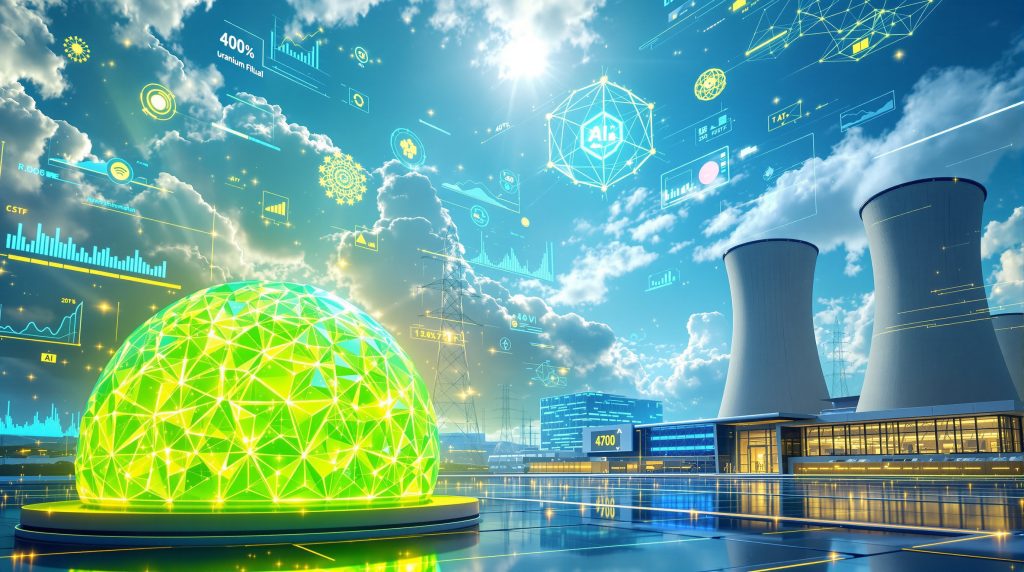The Nuclear Revolution Transforming Energy Markets
Artificial intelligence's explosive growth has created an unprecedented energy challenge that traditional power sources cannot adequately address. The convergence of AI workloads and nuclear energy represents a fundamental shift in global electricity generation, driven by the unique requirements of data centers that demand continuous, reliable power delivery without interruption. This AI-driven nuclear renaissance is transforming how we approach energy infrastructure for the digital age.
Modern AI applications require computational infrastructure that operates continuously, consuming massive amounts of electricity around the clock. Unlike traditional computing workloads that experience daily and seasonal variations, AI training and inference operations maintain consistent power demands that renewable energy sources struggle to meet without substantial backup systems.
The nuclear industry has responded to this challenge by integrating advanced technologies that optimise power generation for AI infrastructure requirements. This transformation extends beyond simple electricity production to encompass intelligent grid management, predictive maintenance, and automated safety systems that ensure reliable operation under demanding conditions.
Advanced Nuclear Technologies Enable AI Integration
Machine Learning Applications Transform Nuclear Operations
Nuclear facilities now employ sophisticated algorithms to monitor thousands of operational parameters simultaneously, creating predictive models that identify potential equipment issues weeks before failures occur. These systems analyse vibration patterns, temperature fluctuations, and coolant flow rates with precision that exceeds human operator capabilities.
The International Atomic Energy Agency reports that modern AI systems can process over 50,000 operational parameters per second in advanced reactor designs. This real-time analysis enables operators to optimise performance while maintaining strict safety protocols, reducing unplanned downtime by 30-40% compared to traditional monitoring approaches.
Digital Twin Technology Revolutionises Reactor Management
Advanced nuclear plants employ physics-based digital replicas that simulate reactor behaviour in real-time, allowing operators to test scenarios and optimise configurations in virtual environments before implementing changes in physical systems. The UK's Advanced Manufacturing Research Centre demonstrates that digital twin technology reduces operational testing costs by approximately 25% while accelerating testing cycles from months to weeks.
These digital systems enable comprehensive fault scenario modelling and optimisation strategy testing without risking actual reactor operations. Tennessee Valley Authority's implementation of AI-driven operational systems has improved capacity factors by 2-3 percentage points while reducing manual operational adjustments.
Technology Giants Drive Nuclear Energy Demand
The exponential growth of artificial intelligence applications has created energy requirements that traditional power sources cannot reliably satisfy. Major technology corporations are investing billions in nuclear infrastructure to secure dedicated, carbon-free electricity for their expanding data center operations. Furthermore, this private sector commitment represents a significant shift in nuclear market dynamics.
Microsoft's Strategic Nuclear Partnership
Microsoft's commitment to restart Pennsylvania's Three Mile Island facility through a 20-year power purchase agreement demonstrates how technology companies are securing dedicated nuclear capacity. This arrangement provides 835 megawatts of continuous power specifically for Azure cloud services and AI processing centers, representing one of the largest single power commitments by a technology company to a specific nuclear facility.
The agreement structure provides Microsoft with guaranteed baseload capacity available 24/7 regardless of weather conditions, along with price stability mechanisms that protect against electricity market volatility. This represents a fundamental shift from speculative energy procurement to strategic infrastructure investment.
Amazon's Small Modular Reactor Initiative
Amazon Web Services has committed substantial capital to developing next-generation small modular reactors that can be deployed closer to data centers, reducing transmission losses and improving grid reliability for AI workloads. AWS sustainability reports indicate pilot projects planned in multiple U.S. states targeting completion by 2028-2030.
Google's Nuclear Infrastructure Commitments
Google's nuclear commitments focus on advanced reactor technologies that provide flexible, on-demand power scaling to match the variable computational demands of machine learning operations. Alphabet's investor relations filings indicate Google has signed letters of intent for nuclear power capacity sufficient to power three additional hyperscale data centers.
Revolutionary Nuclear Technologies Drive the AI-Driven Nuclear Renaissance
Small Modular Reactors Enable Flexible Deployment
Small modular reactors represent a paradigm shift in nuclear design, offering factory-built units that can be deployed rapidly and scaled according to energy demand. The International Atomic Energy Agency reports over 80 SMR designs under development globally, with approximately 20 advancing toward commercialisation.
| SMR Technology | Power Output | Deployment Timeline | AI Integration Features |
|---|---|---|---|
| NuScale VOYGR | 77 MW per module | 2029-2030 | Automated load following |
| Rolls-Royce SMR | 470 MW | 2031-2032 | Digital control systems |
| TerraPower Natrium | 345 MW | 2030-2031 | Molten salt energy storage |
These systems integrate seamlessly with AI-powered grid management systems to provide responsive power generation. NuScale's design enables automated load following capabilities, allowing reactors to adjust power output in 10-20 minute intervals rather than the 2-4 hour response time typical of conventional nuclear plants.
Generation IV Reactor Technologies
Next-generation reactor designs incorporate AI from initial conception, featuring autonomous safety systems, predictive maintenance protocols, and intelligent fuel management that optimise performance without human intervention. These reactors operate at higher temperatures (400-1000°C depending on design) compared to Generation III designs (~320°C), enabling improved efficiency and potential process heat applications.
Advanced designs incorporate:
- Autonomous Safety Systems: Passive safety mechanisms using natural circulation and thermosiphon effects to remove decay heat without active cooling or operator intervention
- Predictive Thermal Management: Machine learning algorithms managing thermal cycling in heat exchangers, extending component lifecycle by 15-25%
- Automated Safety System Testing: Continuous verification protocols that ensure safety systems remain operational without manual intervention
Structural Demand Differentiates Current Nuclear Revival
Private Sector Necessity Versus Policy Mandates
Unlike historical nuclear booms driven by government policy or speculative investment, the current AI-driven nuclear renaissance stems from fundamental energy requirements that cannot be met through alternative sources. The International Energy Agency's analysis indicates this represents the first time in modern nuclear history that private sector demand drivers exceed government policy incentives as the primary growth catalyst.
Historical nuclear cycles experienced significant challenges:
- 1970s-1980s boom: Driven by oil crises and government mandates, resulted in 60% project cost overruns and construction delays averaging 5-7 years
- 1990s-2000s cycle: Speculative investments based on deregulation expectations resulted in minimal net new capacity additions
- Current cycle: Private sector baseload requirements exceed government policy incentives for the first time
Long-Term Contract Commitments Provide Revenue Certainty
Technology companies are signing multi-decade power purchase agreements that provide nuclear developers with unprecedented revenue certainty. The World Nuclear Association reports technology companies have signed 15+ long-term power purchase agreements for nuclear capacity, compared to virtually zero such contracts in previous cycles.
These agreements feature:
- Fixed pricing mechanisms: Extending 15-30 years with guaranteed offtake quantities
- Minimum capacity requirements: 90-95% annual capacity utilisation guarantees
- Financial penalties: $50-150 per MWh for non-delivery, depending on contract terms
24/7 Baseload Requirements Create Structural Demand
AI data centers require constant power availability that renewable sources cannot provide without massive battery storage investments. The U.S. Department of Energy reports hyperscale data centers operate at 92-98% utilisation year-round, contrasting with traditional power generation demand that exhibits 30-50% seasonal and daily variation.
Renewable Energy Limitations for AI Infrastructure:
- Solar capacity factors average 15-25% (varies by geography)
- Wind capacity factors average 25-40% (varies by geography)
- Achieving 99.9% reliability requires battery storage with 6-12+ hours duration
- Current battery storage costs: $100-150 per kWh
A data center requiring 20-50 MWh of storage would require $2-7.5 billion in battery infrastructure, whilst nuclear plants achieve 92-95% capacity factors without intermittency challenges.
Investment Markets Respond to Nuclear AI Demand
Uranium Market Experiences Significant Volatility
The uranium market has experienced substantial price movements as investors recognise the long-term implications of AI-driven nuclear demand. Moreover, the uranium market volatility has intensified with spot prices increasing 26% over six months, reaching $82-83 per pound as utilities secure fuel supplies for planned reactor restarts and new construction projects.
Supply-Demand Imbalance Projections
| Year | Projected Demand (Million lbs) | Projected Supply (Million lbs) | Supply Gap |
|---|---|---|---|
| 2025 | 195 | 180 | -15 |
| 2026 | 210 | 185 | -25 |
| 2027 | 225 | 195 | -30 |
| 2028 | 240 | 205 | -35 |
The World Nuclear Association projects supply deficits of 20-30% annually through 2030 without significant new mine development. Consequently, global uranium supply faces structural constraints as production capacity utilisation declines whilst demand increases from both traditional nuclear plants and new AI-driven facilities. Additionally, US uranium production faces challenges amid supply chain disruptions and regulatory uncertainties.
Australian Securities Exchange Uranium Stock Performance
ASX-listed uranium companies have experienced significant gains as investors position for sustained higher uranium prices. However, recent developments including Paladin uranium halt operations have created additional market uncertainty.
Paladin Energy (ASX: PDN):
- Operations: Langer Heinrich Mine in Namibia (currently operating and ramping production)
- Production Target: 5.2 million pounds annually
- Operating Costs: $35-40/lb all-in sustaining costs
- Current Valuation: Trades at approximately 1.2x Net Asset Value
- Recent Performance: 8-12% weekly gains during market rallies
Boss Energy (ASX: BOE):
- Project: Honeymoon, South Australia (recently restarted)
- Production Target: 2.45 million pounds annually
- All-in Sustaining Costs: Projected around $40/lb
- Financial Position: $135 million cash providing 18-month operational runway
- Recent Performance: Similar 8-12% weekly gains
Deep Yellow (ASX: DYL):
- Project: Tumas Project, Namibia
- Production Timeline: Targeting 2026 production start
- Projected Costs: $35-40/lb all-in sustaining costs
- Development Status: Well-funded without immediate dilution risk
Bannerman Energy (ASX: BMN):
- Project: Etango project showing compelling economics above $70/lb uranium
- Pre-tax NPV: $500+ million at current prices
- Timeline: 2027-2028 production target
- Status: Still requires project financing
Key Challenges Facing Nuclear AI Integration
Regulatory Framework Adaptation
Nuclear regulatory agencies worldwide are updating licensing procedures to accommodate AI-integrated reactor designs whilst maintaining stringent safety standards. The Nuclear Regulatory Commission has certified NuScale's design and is in final stages of approving the Idaho National Laboratory project, representing the first SMR design certification in the United States. Furthermore, US Senate uranium ban legislation adds complexity to supply chain planning.
Cybersecurity for Connected Nuclear Systems
The integration of AI systems with nuclear operations creates cybersecurity vulnerabilities requiring sophisticated protection protocols and continuous monitoring systems. Connected nuclear facilities must implement multilayered security architectures that protect both operational technology and information technology systems from potential threats.
Technical Integration Challenges
AI Model Validation Requirements:
Ensuring AI algorithms perform reliably in nuclear environments requires extensive testing and validation processes that can extend development timelines and increase costs. Nuclear-grade AI systems must demonstrate performance under extreme conditions including radiation exposure, temperature variations, and electromagnetic interference.
Human-AI Collaboration Systems:
Developing effective interfaces between human operators and AI systems remains crucial for maintaining operational oversight whilst leveraging automated capabilities. This requires sophisticated training programmes and interface designs that enable seamless collaboration between human expertise and artificial intelligence.
Global Energy Market Transformation
Geopolitical Implications
Nuclear Fuel Supply Chain Security:
Countries are reassessing nuclear fuel supply chains to reduce dependence on geopolitically sensitive regions whilst ensuring adequate uranium supplies for expanded nuclear programmes. In addition, this includes developing domestic uranium enrichment capabilities and diversifying supply sources across multiple countries and regions. The potential impact of US uranium tariffs further complicates international supply arrangements.
International Technology Cooperation:
The AI-driven nuclear renaissance drives new international partnerships as countries collaborate on advanced reactor technologies and share expertise in AI-enhanced nuclear operations. Technology transfer agreements enable smaller nations to access advanced nuclear technologies whilst contributing specialised expertise in software development and system integration.
Economic Development Opportunities
Energy Cost Stability for Technology Operations:
Nuclear power provides long-term price stability that enables technology companies to plan AI infrastructure investments with greater financial certainty compared to fossil fuel alternatives. The levelised cost of electricity from nuclear plants ($70-90/MWh) becomes increasingly competitive when factoring in reliability requirements for continuous AI operations.
Regional Economic Growth:
New nuclear facilities designed to support AI data centres create high-skilled employment opportunities and drive economic growth in regions hosting these integrated energy-computing complexes. Each new nuclear facility generates approximately 400-700 permanent jobs plus additional indirect economic benefits for surrounding communities.
Future Projections for AI-Driven Nuclear Power
Conservative Growth Trajectory
Under conservative assumptions, the AI-driven nuclear renaissance could add 50-75 gigawatts of new nuclear capacity globally by 2035, representing a 15-20% increase over current installed capacity. This scenario assumes moderate AI expansion and gradual deployment of advanced reactor technologies.
Accelerated Adoption Scenario
Aggressive AI expansion could drive demand for 100-150 gigawatts of new nuclear capacity by 2035, fundamentally reshaping global electricity markets and nuclear industry economics. This scenario requires successful deployment of multiple SMR designs and sustained technology sector investment in nuclear infrastructure.
Manufacturing Readiness and Scaling
Several SMR developers have begun construction of manufacturing facilities, with production capacity ramping from 2-3 units annually (2027-2029) to 10-15 units annually by 2035. NuScale and X-energy lead manufacturing preparation, with factory construction enabling quality control improvements and cost reduction through mass production.
Technological Convergence Opportunities
Fusion-AI Integration
Fusion power development increasingly depends on AI for plasma control and optimisation, potentially accelerating commercial fusion deployment through machine learning advances. AI algorithms manage the complex electromagnetic fields required to contain fusion reactions, making viable fusion power more achievable than previously projected.
Smart Grid Integration
AI-powered nuclear plants will integrate seamlessly with smart grid systems, providing dynamic load balancing and optimal power distribution for mixed renewable-nuclear energy portfolios. These systems enable nuclear plants to respond to grid conditions in real-time whilst maintaining safety protocols and operational efficiency.
Investment Considerations and Market Psychology
The AI-driven nuclear renaissance presents both significant opportunities and complex challenges for investors and industry participants. Technology companies' commitment to nuclear power creates unprecedented demand certainty whilst driving innovation in reactor design and operational efficiency.
For investors evaluating this sector, success requires understanding both the technical capabilities of AI-enhanced nuclear systems and the long-term energy requirements driving this transformation. The nuclear industry's ability to meet AI's growing energy demands whilst maintaining safety standards and economic viability will determine whether this renaissance represents a temporary market adjustment or a permanent restructuring of global power generation.
Risk Factors and Execution Challenges:
- Production ramp-up complexities: New facilities must demonstrate sustained operation at target capacity levels
- Capital requirement management: Development projects require substantial upfront investment before revenue generation
- Regulatory approval timelines: Licensing processes can extend project timelines beyond initial projections
- Technology integration risks: AI systems must prove reliable in nuclear environments over extended periods
The convergence of artificial intelligence and nuclear energy represents one of the most significant developments in energy markets since the digital revolution began. Unlike previous nuclear cycles driven by policy mandates or speculative investment, this transformation stems from fundamental technological requirements that cannot be addressed through alternative energy sources.
Technology companies' multi-decade power purchase agreements provide nuclear developers with revenue certainty unprecedented in the industry's history. This financial foundation enables project financing and construction timelines that were previously unachievable without government backing. As industry experts note in recent analysis of nuclear power's role in the AI revolution, this convergence represents a fundamentally different approach to energy infrastructure investment.
The success of this AI-driven nuclear renaissance will depend on the industry's ability to deliver reliable, safe, and economically viable power generation that meets the exacting requirements of modern artificial intelligence infrastructure. For stakeholders across the energy and technology sectors, this transformation represents both a significant opportunity and a fundamental shift in how global electricity markets operate.
Ready to Discover the Next Nuclear Revolution Opportunity?
Discovery Alert's proprietary Discovery IQ model delivers instant alerts on significant ASX mining discoveries, including uranium and nuclear-related opportunities that could capitalise on the AI-driven energy transformation. Explore historic examples of major discoveries and their exceptional returns, then begin your 30-day free trial to position yourself ahead of the market in this revolutionary sector.




